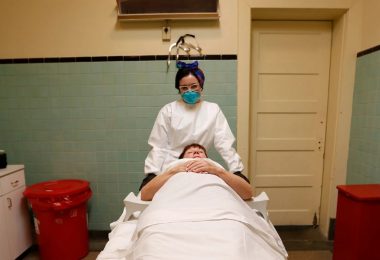
Physical therapists help people cope with chronic medical conditions, recover from health problems, and manage pain. They are often referred to only as P.T.s and play a vital role in enhancing patients’ quality of life. Being a physical therapist requires extensive training and education. This is a rapidly growing profession, so there are plenty of career opportunities. The average physical therapist salary is decent, so you can earn a comfortable living and have the satisfaction of assisting people in making their lives healthier.
The Physical Therapist’s Job
Recovering from an injury or illness often requires more than just expecting for a wound to heal. P.T.s use stretching and exercise to help patients recover a range of function, motion, strength, and mobility. They may guide patients to use assistive devices like walkers and canes and strength training equipment. The P.T.’s task is to improve outcomes after sickness or surgery to help people with chronic health conditions or disabilities minimize the adverse effects of their situations.
The physical therapist’s job begins with the observation of the patient and a review of a patient’s medical history and other information provided by healthcare practitioners. The physical therapist then relies on this background to discuss and guide the patient and conclude what is required and realistic results. The outcome should be an individualized rehabilitation regimen that is a road map for achieving these goals. P.T.s regularly evaluate the person’s progress and modify the therapy plan as needed. P.T.s also try to educate patients about activity and lifestyle changes that promote healing and maximize function.
Physical Therapist Work Environment
Around thirty-five percent of P.T.s work in offices, often alongside speech, hearing, and occupational therapists. Private or public hospitals employ another twenty-six percent. Home healthcare services employ ten percent. Around seven percent of work for residential and nursing facilities, and seven percent are self-employed.
Physical therapists usually work regular business schedules, but some also work weekends or evenings. They spend considerable time on their feed. They must perform significant moving or lifting of patients, so taking precautions to avoid back injuries is essential.
P.T.s must earn a bachelor’s degree with coursework that prepares them for entry into a physical therapist program leading to a DPT (Doctor of Physical Therapy) degree. Undergraduate classes should cover biology, anatomy, physics, chemistry, and physiology. Postgraduate coursework typically includes neuroscience, biomechanics, and pharmacology, as well as supervised clinical practice. The DPT program generally takes 3 years, but prospective P.T.s often complete an additional one-year residency to specialize in an area such as geriatric, orthopedic, or sports physical therapy.
Every state requires P.T.s to be licensed. Typically, states use the NPTE (National Physical Therapy Examination). Many states also require physical therapists to pass a law exam, criminal background check, and/or pursue continuing education.
Recommended Articles ;
How to Become a Physical Therapist Assistant
How to Become Self Employed Physiotherapist
How Much Do Physical Therapists Make
Careers in the U.S:
The average entry-level or starting pay for physical therapists in 2019 was $81,301. Experienced therapists averaged 89,440. Late in their careers, physical therapists’ salaries averaged $96,900. Bureau of Labor Statistics figures show the median annual physical therapist income in 2019 was $89,440. That is, 50 percent made more than the median, and 50 percent made less.
The ten percent who were paid the most received more than $124,740, while those in the lowest 10th-percentile made less than $62,120. The median physical therapist’s salary for nursing and residential facilities was $94,620, and for home healthcare, was $96,900. Those working for private and public hospitals earned a median salary of $91,590. Physical therapists employed in therapists’ offices received $86,720(1).
Careers in Europe:
An entry-level Physiotherapist with less than one year experience can expect to make an average total compensation (includes bonus, tips, and overtime pay) of £23,030. An early career Physiotherapist with 1-5 years of experience makes an average total compensation of £26,040. A mid-career Physiotherapist with 5-10 years of experience makes an average total compensation of £30,955. An experienced Physiotherapist with 10-20 years of experience makes an average total compensation of £34,684. In their late-career (20-plus years), employees make an average total compensation of £35,536.
Careers in Asia:
An entry-level Physiotherapist with less than one year experience can expect to make an average total compensation (includes bonus, tips, and overtime pay) of S$36,000. An early career Physiotherapist with 1-5 years of experience makes an average total compensation of S$40,206. A mid-career Physiotherapist with 5-10 years of experience earns an average total compensation of S$57,000. A Physiotherapist with an experience of 10-20 years of experience makes an average total remuneration of S$60,000. In their late-career (20-plus years), employees make an average total compensation of S$80,000.
Career Outlook
The BLS forecasts a twenty-eight percent growth in physical therapists jobs from 2016 to 2026, which is much more than the average for all professions. The number of elderly Americans is growing, and with it, the number of chronic disorders that require physical therapy like diabetes and arthritis. Another spur to job growth is that elderly adults are staying active later in life. Also, medical breakthroughs are expanding the scope of possible benefits with physical therapy. Opportunities should be specifically good in specialties such as orthopedic and geriatric physical therapy and those who work in rural regions.




